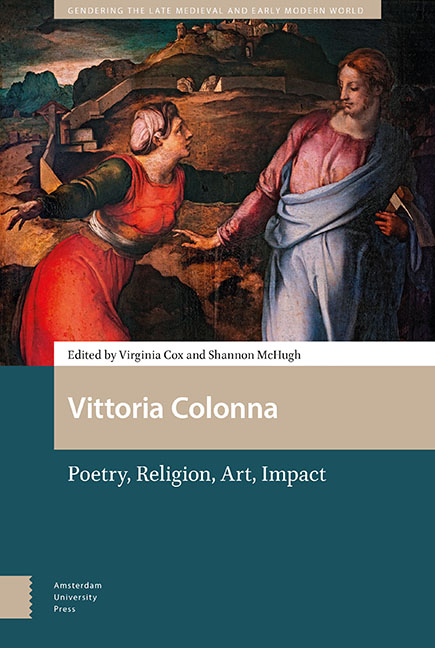Book contents
- Frontmatter
- Dedication
- Contents
- List of Illustrations
- Acknowledgements
- Introduction: The Twenty-First Century Vittoria Colonna
- Part 1 Literary and Spiritual Sociability
- Part 2 Widowhood
- Part 3 Poetry
- Part 4 Art
- Part 5 Readership
- Part 6 Impact
- Volume Bibliography
- Index of Citations of Colonna’s Letters and Verse
- Thematic Index
11 - ‘Leading Others on the Road to Salvation’: Vittoria Colonna and Her Readers
Published online by Cambridge University Press: 16 December 2021
- Frontmatter
- Dedication
- Contents
- List of Illustrations
- Acknowledgements
- Introduction: The Twenty-First Century Vittoria Colonna
- Part 1 Literary and Spiritual Sociability
- Part 2 Widowhood
- Part 3 Poetry
- Part 4 Art
- Part 5 Readership
- Part 6 Impact
- Volume Bibliography
- Index of Citations of Colonna’s Letters and Verse
- Thematic Index
Summary
Abstract
This paper considers the question of Vittoria Colonna's readership beyond the poet's intimate circle of friends and associates. It asks who was reading Vittoria Colonna in print in the sixteenth century and how they were reading her. It examines in particular the passage from ‘high’ to ‘low’ in the print circulation of rime spirituali, and the role played by Colonna's work in defining the reception of the genre, both during its formative period in her lifetime, and in the later sixteenth century, when it had become one of the dominant lyric traditions of the age.
Keywords: lyric poetry, readers, reception, print publication
A small pamphlet printed in Brescia in 1538, authored by Pietro da Lucca but incorrectly attributed to Cherubino da Spoleto, offers advice for widows on how to lead a spiritual life. Surviving in a single copy in the Biblioteca Universitaria in Padua, the pamphlet contains twenty-four sheets of dense type on cheap paper in ottavo. Put together by the pamphlet seller active in the Veneto known as Ippolito Ferrarese, the work offers notably pragmatic advice on how to live a good Christian life. The pamphlet urges its reader to keep only virtuous company, to adopt modesty in dress and to practise generosity to the poor. It also includes a strongly apotropaic element, in a final section containing a long prayer and accompanying rubric: ‘whoever says this prayer of Saint Augustine kneeling with a blessed candle in his hand for a period of forty days will receive all legitimate graces from the Virgin Mary. And he will do this for the health of his soul’. The prayer and rubric indicate that the pamphlet sought to engage, alongside more standard devotional readers, individuals whose desire for texts was closely related to their perceived protective and intercessory qualities.
Ippolito Ferrarese's pamphlet acts as a useful starting point for the following discussion because of the notable fact that it was dedicated to Vittoria Colonna. Colonna's name is included prominently on the title page: ‘To the most Illustrious Lady Vittoria[,] esteemed Marchioness of Pescara’ (All’Ilustre S. Vittoria digniss. Marchesa di Pescara). In addition, a dedicatory letter inside the work alludes to a personal relationship between the aristocratic poet and the ‘pedlar’ (cerretano), Ippolito Ferrarese. Ippolito mentions ‘the many wonderful favours’ done on his behalf by Colonna.
- Type
- Chapter
- Information
- Vittoria ColonnaPoetry, Religion, Art, Impact, pp. 273 - 290Publisher: Amsterdam University PressPrint publication year: 2021

